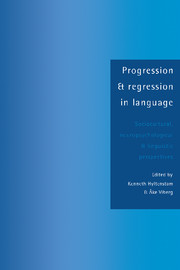 Progression and Regression in Language
Progression and Regression in Language Book contents
- Frontmatter
- Contents
- List of contributors
- Preface
- INTRODUCTION
- THE SOCIOCULTURAL SETTING
- PSYCHO- AND NEUROLINGUISTIC ASPECTS
- 6 Neurolinguistic aspects of first language acquisition and loss
- 7 Neurolinguistic aspects of second language development and attrition
- 8 Second language acquisition as a function of age: research findings and methodological issues
- 9 Second language regression in Alzheimer's dementia
- THE LINGUISTIC PERSPECTIVE 1: DISCOURSE, GRAMMAR, AND LEXIS
- THE LINGUISTIC PERSPECTIVE 2: PHONOLOGY
- Index
8 - Second language acquisition as a function of age: research findings and methodological issues
Published online by Cambridge University Press: 06 July 2010
- Frontmatter
- Contents
- List of contributors
- Preface
- INTRODUCTION
- THE SOCIOCULTURAL SETTING
- PSYCHO- AND NEUROLINGUISTIC ASPECTS
- 6 Neurolinguistic aspects of first language acquisition and loss
- 7 Neurolinguistic aspects of second language development and attrition
- 8 Second language acquisition as a function of age: research findings and methodological issues
- 9 Second language regression in Alzheimer's dementia
- THE LINGUISTIC PERSPECTIVE 1: DISCOURSE, GRAMMAR, AND LEXIS
- THE LINGUISTIC PERSPECTIVE 2: PHONOLOGY
- Index
Summary
The possibility that language acquisition, like so many aspects of human development, is at least partly a function of biological programming has long intrigued students of first and second language acquisition and loss. Demonstrating the existence of maturational constraints, specifically, one or more sensitive periods for language development, would have ramifications both for language acquisition theory and language teaching practice. Language learning after the close of the period(s) identified might be a qualitatively different process, and a theory would have to account for that. The existence of sensitive periods would hold implications for first and second language teaching programmes of various kinds. The type and timing of instruction – either in or through a new language – for abnormal first language, and normal child and adult second language, populations would be influenced, for example, by a finding that native-like abilities in one or more linguistic domains could only be achieved by learners first exposed to a language before a certain age.
A sensitive period, following Oyama (1979), is best conceived as a time of heightened responsiveness to certain kinds of environmental stimuli, bounded on both sides by states of lesser responsiveness, with abrupt or gradual increases or decreases in learning ability expected and sufficient to support the claim. It is recognized, after all, that even some of the clearest cases of sensitive periods in the animal world, such as imprinting, are often not ‘developmentally fixed’ (genetically determined and impervious to environmental influence), and so can be variable.
- Type
- Chapter
- Information
- Progression and Regression in LanguageSociocultural, Neuropsychological and Linguistic Perspectives, pp. 196 - 221Publisher: Cambridge University PressPrint publication year: 1994
